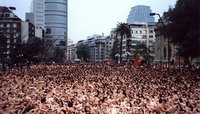 One, two, many multitudes?
One, two, many multitudes?Michael Hardt and Antonio Negri emphasize the singularity of the multitude. To speak of many multitudes would be no more than a concession or a gesture towards liberal humanism: you have your multitude, we have ours, let a thousand multitudes bloom.
No, they insist, there is but one multitude, though that multitude is composed of multiplicities. For if the multitude is already multiple, then it is at best a tautology, at worst a distortion, to pluralize it, to speak of many multitudes.
But how many multitudes are there in Hardt and Negri's own work? And are they compatible? An enumeration is in order.
First, there is the multitude still to appear. It's this multitude that's the focus of the book Multitude. The multitude that is, now, perhaps emergent with the rise of affective labour, with Empire and the exhaustion of concepts such as the popular or class. This multitude is a "coming community" (as Agamben might put it). Its arrival is the horizon or history. Better, its arrival would mean the end of history, the inauguration of Communism.
Second, however, there is the multitude that made its first appearance at the birth of modernity. This is Spinoza's multitude, the multitude associated with the rise of capitalism and the disputes that fractured early modern political philosophy. This is a multitude whose intemperate appearance was soon overcoded by the contrasting notion of the popular. It's in this sense that Paolo Virno can tell us that we are now in a new sixteenth century, replaying the struggle between multitude and people, Spinoza and Hobbes, that had earlier been resolved, albeit temporarily, in favour of the people.
Third, then, there is the multitude as remnant and subterranean presence throughout modernity. For the historical multitude could not be so easily dispatched, and it reappeared at every time of crisis and rebellion. This is the multitude of Negri's Insurgencies, that rises anew with the English, French, American, and Russian Revolutions, only each time to be (ever more precariously) repressed by the new Thermidors that win out.
Fourth, as a consequence, Negri can suggest an ontological multitude. Beyond these occasional appearances, the multitude is the ground of modernity and social cohesion tout court. This is the multitude that we can identify fully with constituent power. It's a multitude always at work, but actualized in other, distorted, forms according to the regime of constituted power of the moment.
But in the slippage between constituted and constituent power, is there not a fifth multitude? A multitude that forms and coalesces along the lines of flight within each and every social formation? A multitude then that is sociological, incarnated in piracy, in everyday life, in Temporary Autonomous Zones, in the quotidian refusals and resistances by which we make our lives bearable. This multitude is actual, rather than simply virtual. We already share in and participate its activity.
So, a multitude to come. A historical origin. A periodic irruption into history. An absolute ground. The very fabric of the everyday.
Again, are these all one and the same multitude?
[Update: Now go read Nate's thought-provoking response to this post.]
No comments:
Post a Comment